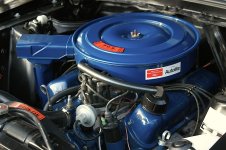robert campbell
Well-known member
- Joined
- Apr 10, 2007
- Messages
- 4,321
Could a couple of you guys with a basically stock long block 289 or 302 do a vacuum test for me? No problem if you have a different carb, but want the test performed on a stock engine and camshaft mostly.
I especially would like to test an engine with an automatic. Hot idle in gear from an intake vacuum source. I would assume in park or a manual car to see somewhere in the 17 to 18 psi range. In gear I would imagine a drop down towards 15 psi.
If a couple of you do this it would be helpful. This car I just finished in the other thread runs lower vacuum than it should in my mind. Its cam is unknown, but it surprised me.
Thanks for doing this. I will test some other cars myself if I get one over.
Rob
I especially would like to test an engine with an automatic. Hot idle in gear from an intake vacuum source. I would assume in park or a manual car to see somewhere in the 17 to 18 psi range. In gear I would imagine a drop down towards 15 psi.
If a couple of you do this it would be helpful. This car I just finished in the other thread runs lower vacuum than it should in my mind. Its cam is unknown, but it surprised me.
Thanks for doing this. I will test some other cars myself if I get one over.
Rob

